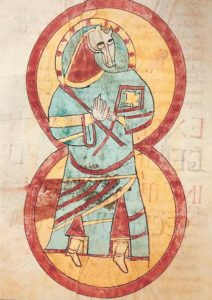Un breton au service des Orléans: Hugues de Guingamp (ca 1349-ca 1424)
Parmi les quelques secrétaires bretons qui ont marqué notre histoire nationale au XIVe siècle, aux côtés des Yves Simon et Yves Derien, figure Hugues de Guingamp.

La signature de Hugues de Guingamp. 24 septembre 1396. (c) New York, Columbia University, Rare Book and Manuscript Library Smith Documents 0198
[Lien]
La très utile base \ »Opération Charles VI\ » mise en ligne sur le site du LAMOP [Lien] énumère les diffèrentes fonctions exercées par Hugues de Guingamp. Elles sont assez impressionnantes:
* Auditeur des comptes du duc Louis d’Orléans
* Concierge de l’hôtel de Nesploy
* Conseiller de la duchesse d’Orléans, Valentine Visconti
* Employé aux requètes de l’Hôtel du roi
* Garde des chartes et joyaux du duc et de la duchesse d’Orléans
* Greffier de la chambre des comptes
* Maître lai extraordinaire des comptes
* Membre du conseil du roi Charles VI
* Notaire à la chambre des comptes
* Notaire du roi
* Procureur général des serviteurs du comte de Valois Louis de France
* Secrétaire du duc Charles d’Orléans
* Secrétaire du duc Louis d’Orléans
Hugues de Guingamp fut d’abord clerc et secrétaire du roi (1385), puis conseiller du roi, du duc d’Orléans en leur Chambre des comptes, garde des chartes du duc (1391-1403), enfin auditeur des comptes (1406). Il reçut en 1394 deux cent francs de récompense pour avoir surveillé la construction de la chapelle des Célestins que Louis d’Orléans faisait construire.
Son écu était à un chevron hochant sur un aigle et cantonné de mouchetures d’hermine (BnF Cabinet des titres PO 1448, n° 32835, 4-22)
Quelques sources manuscrites en rapport avec Hugues de Guingant:
(Archives de Joursanvault)
[2892] 1392: Louis, duc d’Orléans, nomme Jean Prunelle et Hugues de Guingant, pour prendre possession, en son nom, de plusieurs fiefs, et recevoir l’hommage de ses vassaux.
[2927] 1402. Compte particulier de Hugues de Guingant, conseiller du duc d’Orléans, pour les dépenses qu’il a faites dans plusieurs voyages en Orléanais.
[3614] 1394. Le duc Louis d’Orléans nomme Alain de Beaumont et Hugues de Guingamp administrateurs de son domaine de Sablé.
A ce dernier document rattacher cet acte (Catalogue de livres rares et précieux, Manuscrits et chartes originales, Paris, Techener, 1849, n° 1255:)
Loys, duc d’Orléans, mande à son trésorier de payer 90 francs d’or à Hugues de Guingant, son secrétaire, qui doit aller avec Alain de Beaumont pendre possession du château de Sablé, qu il venait d’acheter de sa tante la reine de Jérusalem et de Sicile. — 22 sept. 1394. — Or. — Débris du scel.
25 juin 1391: Inventaire fait le xxve jour du mois de juing, l’an mil ccc IIIJxx et onze, par nous, Hugue de Guingant et Jehan Gilet, secrétaires de MS le duc de Touraine, présent Jehan Poulain, varlet de chambre et garde des finances dudit MS le duc, et les chiefs des offices d’icelui seigneur, lesquelz ont été avec ledit seigneur ou voyage qu’il a naguères fait ès parties de Lombardie, des joyaulz, vaisselle d’or et d’argent, et autres choses rapportées dudit voyage par lesdiz chiefs d’offices (Paris AN K 264).
14 mars 1394: Parties d’escriptures faictes par Jehan de Villebresme, du commandement et ordonnance de MS le chancellier d’Orliens et de maistre Hugues de Guingant, secrétaire du Roy, du roy NS et de MS le duc d’Orliens et maistre des comptes et garde des chartes et priviléges d’icelui MS le duc. (Le comte de Laborde, Les ducs de Bourgogne. Etudes sur les lettres, les arts et l’industrie, III, p. 55, 100)
Hugues de Guingamp hérita des biens de Nicolas d’Orgemont, chanoine de Notre Dame, dit le boiteux, condamné en 1415 comme membre du parti bourguignon à la privation de ses offices [Lien]
Pierre Cockshaw († 15 mars 2008)
Denis Muzerelle, responsable de la section \ »Paléographie latine\ » à l’IRHT, nous apprend le décès de Pierre COCKSHAW, survenu le 15 mars dernier, dans le cours de sa soixante-dixième année.
Membre de l’Académie royale de Belgique depuis 1993, Conservateur en chef de la Bibliothèque royale de Belgique de 1992 à 2003 et professeur honoraire de l’Université libre de Bruxelles, Pierre Cockshaw était membre du C.I.P.L. depuis 1993.
Les funérailles auront lieu le jeudi 20 mars 2008, à 9 h 30, au Crematorium d’Uccle.
Laboratoire de médiévistique occidentale de Paris : Les regroupements textuels au Moyen Âge
Les regroupements textuels au Moyen Âge. Exploitation, fonctionnalités et logiques de rassemblement entre collection manuscrite et archive. Tel sera le thème abordé lors des Journées d’études des 20 et 21 mars 2008 du LAMOP (Laboratoire de médiévistique occidentale de Paris C.N.R.S/U.M.R 8589, Villejuif 7, rue Guy Môquet, Batiment C)
Jeudi 20 mars. Matin. Présidence: Jean-Philippe Genet
10h00 – Benoît Grévin, « De la collection épistolaire au formulaire de chancellerie (XIIIe-XVe siècle): enquêtes fonctionnalistes, transitions typologiques et fractures disciplinaires »
11h00 – Wagih Azzam, Olivier Collet, Yasmina Foehr Janssens, « Mise en recueil et fonctionnalité de l’écrit »
Après-midi. Présidence: Monique Goulet
14h00 – Stéphane Gioanni, « La littérature patristique dans les collections médiévales: réceptions et réécritures »
15h00 – David Ganz, « Les collections de capitulaires carolingiens (IXe siècle) : traitement documentaire et approche littéraire »
16h00 Caroline Bourlet, « La fonction des compilations produites par les administrations à Paris: quelques jalons à travers deux exemples (prieuré Saint-Martin des Champs et réglementations de métier) »
Vendredi 21 mars. Matin. Présidence: Claude Gauvard
10h00 – Richard Trachsler, « De l’objet au texte et vice versa. Le statut du recueil manuscrit dans les études de la littérature du Moyen Âge »
11h00 – Pierre Chastang, « Des archives au codex : les enjeux de la rédaction des cartulaires (XIe-XIVe siècle) »
Après-midi. Présidence: Dominique Iognia-Prat
14h00 – Etienne Anheim, « Enquête préliminaire sur les recueils de pièces polyphoniques entre le milieu du XIVe et le début du XVe siècle. Typologie, circulation, intertextualité »
15h00 – Damien Kempf, « Réflexions sur les regroupements textuels des Chroniques de la Première croisade »
Inscriptions: benoit.grevin@orange.fr
Site LAMOP [Lien]
Peintres et enlumineurs à Guingamp à la fin du XVe s.
Texte publié dans : Jean-Luc Deuffic, Notes de biblilogie. Livres d’heures et manuscrits du Moyen Age identifiés, dans Pecia. Le livre et l’écrit, 7, 2009 [Lien].
PAGES ANNEXES
Auteur du blog : Jean-Luc DEUFFIC




